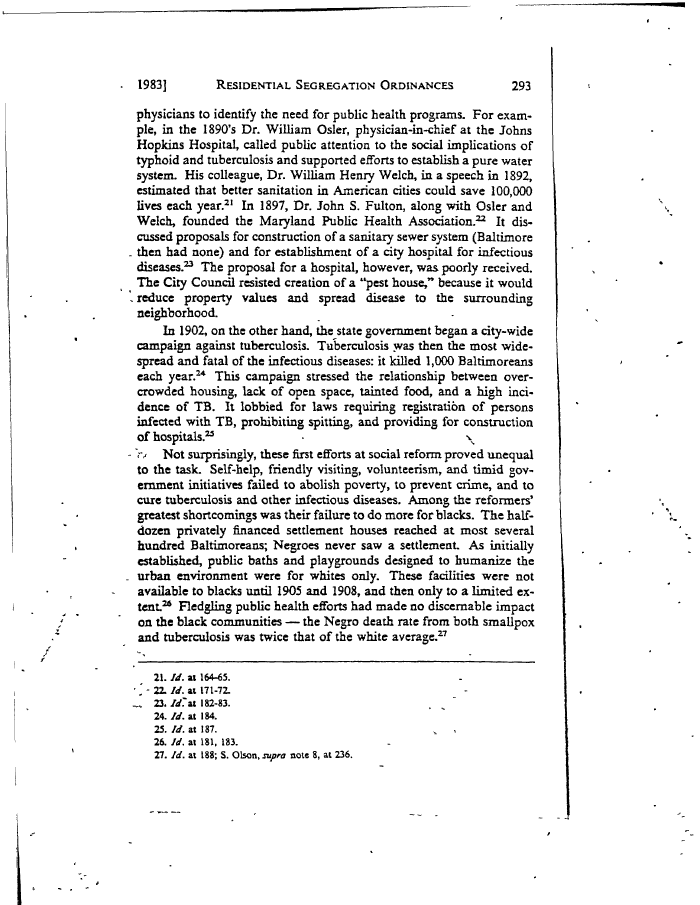 |
||||
|
Garrett Power, Apartheid Baltimore Style: The Residential Segregation Ordinances of 1910-1913, Maryland Law Review, 42 (1983) , Image No: 6 Enlarge and print image (60K) << PREVIOUS NEXT >> |
 |
||||
|
Garrett Power, Apartheid Baltimore Style: The Residential Segregation Ordinances of 1910-1913, Maryland Law Review, 42 (1983) , Image No: 6 Enlarge and print image (60K) << PREVIOUS NEXT >> |
| 1983] RESIDENTIAL SEGREGATION ORDINANCES 293 physicians to identify the need for public health programs. For exam- ple, in the 1890's Dr. William Osler, physician-in-chief at the Johns Hopkins Hospital, called public attention to the social implications of typhoid and tuberculosis and supported efforts to establish a pure water system. His colleague, Dr. William Henry Welch, in a speech in 1892, estimated that better sanitation in American cities could save 100,000 lives each year.21 In 1897, Dr. John S. Fulton, along with Osler and Welch, founded the Maryland Public Health Association.22 It dis- cussed proposals for construction of a sanitary sewer system (Baltimore then had none) and for establishment of a city hospital for infectious diseases.23 The proposal for a hospital, however, was poorly received. The City Council resisted creation of a "pest house," because it would reduce property values and spread disease to the surrounding neighborhood. In 1902, on the other hand, the state government began a city-wide campaign against tuberculosis. Tuberculosis was then the most wide- spread and fatal of the infectious diseases: it killed 1,000 Baltimoreans each year.24 This campaign stressed the relationship between over- crowded housing, lack of open space, tainted food, and a high inci- dence of TB. It lobbied for laws requiring registration of persons infected with TB, prohibiting spitting, and providing for construction of hospitals.23 • \ Not surprisingly, these first efforts at social reform proved unequal to the task. Self-help, friendly visiting, volunteerism, and timid gov- ernment initiatives failed to abolish poverty, to prevent crime, and to cure tuberculosis and other infectious diseases. Among the reformers' greatest shortcomings was their failure to do more for blacks. The half- dozen privately financed settlement houses reached at most several hundred Baltimoreans; Negroes never saw a settlement As initially established, public baths and playgrounds designed to humanize the urban environment were for whites only. These facilities were not available to blacks until 1905 and 1908, and then only to a limited ex- tent.24 Fledgling public health efforts had made no discernable impact on the black communities — the Negro death rate from both smallpox and tuberculosis was twice that of the white average.27 21. Id. at 164-65. 22. Id. at 171-7Z 23. Id. at 182-83. 24. Id. at 184. 25. Id. at 187. 26. Id. at 181, 183. 27. Id. at 188; S. Olson, supra note 8, at 236. |